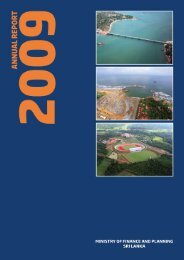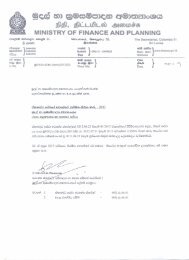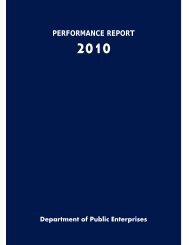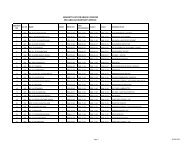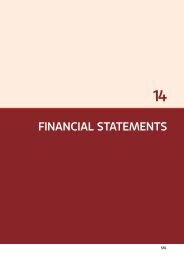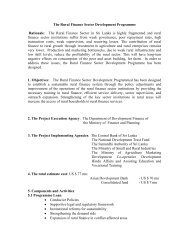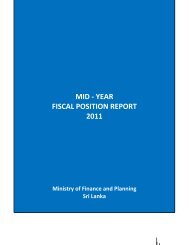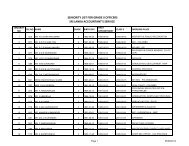Annual Report 2008 - Ministry of Finance and Planning
Annual Report 2008 - Ministry of Finance and Planning
Annual Report 2008 - Ministry of Finance and Planning
You also want an ePaper? Increase the reach of your titles
YUMPU automatically turns print PDFs into web optimized ePapers that Google loves.
1. Macro Economic Perspectives<br />
30<br />
Government initiatives such as the introduction <strong>of</strong> an isl<strong>and</strong><br />
wide food programme <strong>and</strong> minimum purchase price for<br />
paddy <strong>and</strong> milk, grant <strong>of</strong> the fertilizer subsidy even amidst<br />
a very high world price environment, interventions by the<br />
government to purchase paddy <strong>and</strong> enhance investment<br />
in irrigation facilities also boosted the output <strong>of</strong> agriculture<br />
sector. The provision <strong>of</strong> agricultural equipment <strong>and</strong> seeds<br />
especially to farmers in the East to reawaken areas that<br />
suffered due to terrorism, continuous government support<br />
through tax exemptions, credit facilities <strong>and</strong> interest<br />
subsidies also created a conducive environment to improve<br />
sectoral performance. Government also continued with<br />
the tax structure with a view to discourage agricultural<br />
imports.<br />
Industry Sector Records a Moderate Growth Amidst<br />
Challenges<br />
Withst<strong>and</strong>ing the declining dem<strong>and</strong> following the slowdown<br />
in major economies, the high cost <strong>of</strong> production stemming<br />
from high oil prices <strong>and</strong> resultant domestic price increases,<br />
value addition in the industrial sector grew by 5.9 percent in<br />
<strong>2008</strong> compared to the 7.6 percent witnessed in 2007. All four<br />
sub sectors namely mining <strong>and</strong> quarrying, manufacturing,<br />
electricity, gas <strong>and</strong> water, <strong>and</strong> construction contributed<br />
favourably for the growth in the sector.<br />
The factory industry grew by 5 percent in <strong>2008</strong>, compared<br />
to 6.7 percent growth in 2007. This achievement should<br />
be viewed in a backdrop <strong>of</strong> relatively high erosion in the<br />
competitiveness stemming from high cost <strong>of</strong> electricity, fuel,<br />
water <strong>and</strong> interest cost, coupled with declining dem<strong>and</strong><br />
conditions in major export destinations <strong>and</strong> slow domestic<br />
dem<strong>and</strong> due to the tight monetary policy stance adopted by<br />
the Central Bank <strong>of</strong> Sri Lanka.<br />
The performance <strong>of</strong> export oriented industries deteriorated<br />
especially towards the latter part <strong>of</strong> <strong>2008</strong>, due to weakening<br />
global economic conditions <strong>and</strong> stiff competitions from<br />
low cost manufacturing countries such as China, India<br />
<strong>and</strong> Cambodia. The major export oriented industries being<br />
apparel <strong>and</strong> leather sectors recorded a slower growth <strong>of</strong> 3.1<br />
percent in <strong>2008</strong>, due to external pressures, consequent to<br />
major buyers adopting a more cautious approach in placing<br />
the orders due to the economic slowdown. Even under<br />
difficult conditions, the apparel <strong>and</strong> garment exports reached<br />
to US $ 3,469 million in <strong>2008</strong>. Easing <strong>of</strong> the uncertainties in<br />
the EU markets owing to the retention <strong>of</strong> the GSP + facility<br />
for a further period <strong>of</strong> three years from 2009 <strong>and</strong> major<br />
players consolidating through mergers, <strong>and</strong> being ready to<br />
face competition by adopting eco friendly manufacturing<br />
mechanisms facilitating solid waste management <strong>and</strong><br />
low carbon emission, thereby helping the apparel sector to<br />
withst<strong>and</strong> related global pressures.<br />
Table 1.5<br />
Manufacturing Sector Statistics<br />
Value Addition Number <strong>of</strong> Projects Industrial Volume<br />
(current price) Rs. Bn Approved by BOI Index (1997=100)<br />
Category 2006 2007 <strong>2008</strong> 2006 2007 <strong>2008</strong> 2006 2007 <strong>2008</strong><br />
Food beverages <strong>and</strong> Tobacco Products 242 283 348 30 53 34 151.9 161.5 169.9<br />
Textiles, Wearing Apparel <strong>and</strong> Leather 114 132 348 35 35 17 142.7 151.6 156.6<br />
Wood <strong>and</strong> Wood Products 1.2 1.4 1.4 7 14 8 126.9 133.3 140.2<br />
Paper <strong>and</strong> Paper Products 4 5 6 5 5 2 127.7 134.5 142<br />
Chemical/Petroleum/Coal/Rubber<br />
<strong>and</strong> Plastic Products 95 113 135 18 27 12 174.5 187 198.5<br />
Basic Metal Products 18 20 23 10 19 15 157.8 171.5 178.3<br />
Fabricated Metal Products,<br />
Machinery <strong>and</strong> Transport Equipment 39 48 55 9 27 21 144.6 151.5 159.5<br />
Manufactured Products n.e. Specified 1.9 2.2 2.5 10 28 30 133.7 140.8 147.6<br />
Source:<br />
Central Bank <strong>of</strong> Sri Lanka<br />
Department <strong>of</strong> Census <strong>and</strong> Statistics<br />
Board <strong>of</strong> Investment (BOI)<br />
<strong>Ministry</strong> <strong>of</strong> <strong>Finance</strong> <strong>and</strong> <strong>Planning</strong> Sri Lanka<br />
<strong>Annual</strong> <strong>Report</strong> <strong>2008</strong>






